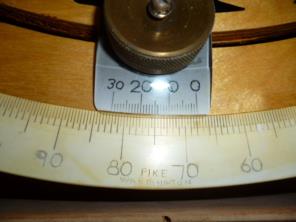
NavList:
A Community Devoted to the Preservation and Practice of Celestial Navigation and Other Methods of Traditional Wayfinding
From: Brad Morris
Date: 2015 Oct 19, 03:27 -0400
Hello John
You are certainly entitled to your opinion. You like drum micrometers instead of vernier sextants. That's okay in so far as it goes.
But then you state
"Vernier’s serve a purpose when the precision of one minute either way won’t make that much of a difference."
That is simply incorrect. I have two vernier instruments. One has an arc accuracy of 0'0" throughout the entire arc. The other states an arc accuracy not to exceed 0'5" back in 1905.
As to reading the instruments, I find little or no difficulty in determining which line is closest, using the attached magnifying glass, in a fairly rapid manner. Each instrument is graduated to 10", yet the Circle of Reflection has two verniers mounted 180° apart, yielding 5" (just under 0.1').
So your claim of only +/-1' for a vernier must yield to the truth. It is not true. They are certainly more accurate than that. By far.
As to your claim that vernier sextants were reserved only for lifeboats, that is untrue. Verniers were used extensively and by everyone. Why? Because the drum had not been invented yet. Nor were drums rapidly and universally accepted until well after their invention.
If we accept the 1970s as the birth of satellite navigation, then drum sextants held dominance for only a very few decades, as compared with the centuries during which the vernier held sway.
This conversation comes up every few years, in which the vernier is maligned because the author prefers the drum. Simply put, with practice, you will achieve identical accuracy IMHO with both devices.
Brad
As an interesting side note, you never have to remember to approach contact in the same direction with a vernier. The tangent screw does not provide the reading, and as such, gear lash is irrelevant. With a micrometer drum, you do. So be careful out there ;-)
Ah, but doesn’t the ability to magnify the vernier scale really image make all the difference?
Why the manufactures stopped installing magnifying glasses on the arms of sextants is beyond me.
The idea of snapping a pic and then downloading it and magnifying it that way is time consuming.
When you need a report right at the time the assistant calls mark! or kicks you lightly in the foot, you have to have a locked in position to report.
If the arm can be mobilized and not subject to jarring until you can get back to the chart table, fine, but even a calm sea will subject even an aircraft carrier to “choppiness.”
Therefore, the best reading is that taken at the time of MARK because that is what the navigator got at the moment of time’s mark and his sighting.
It’s not as complicated as it sounds, and yet a drum just makes reading the minutes a lot easier and convenient.
Vernier’s serve a purpose when the precision of one minute either way won’t make that much of a difference. That is why they were used in lifeboats, not that survivors have to be all that precise, just to know where they are in general. And to pray for being spotted. The Hitchcock movie “Lifeboat” is a good character study of what lifeboat life is like.
Leave vernier scales for the life rafts and boats, and keep the micrometer drum for everyday and standard use. That is why the Davis Mk 3 deserves a spot in every ditch bag. Its durable enough to be bumped and tossed about and it isn’t a cumbersome balanced instrument the way a “real” sextant is. “real” is relative in that all sextants vernier or drum will give you a report, how valuable and precise the report you get is another and the REAL story.
Rommel John Miller
8679 Island Pointe Drive
Hebron, MD 21830-1093
410-219-2690 (Land and Home)
443-365-7925 (Cell)
From: NavList@fer3.com [mailto:NavList@fer3.com] On Behalf Of David Pike
Sent: Sunday, October 18, 2015 4:12 PM
To: rommeljohnmiller---.com
Subject: [NavList] Re: Degrees and minutes vs decimal degrees andtheDaily Pages
Stan you said "vernier sextants are impossible to use anyway ;-)"
I'm not sure what you meant by that. Did you mean sextants with the vernier against the arc, or sextants with a vernier against the drum? Did you mean the vernier itself was impossible to use, or were you referring to the fact that they're probably quite old and have smaller mirrors than todays sextants and the marks on the arc are getting worn? Perhaps you just meant you have to stare at the reading for a long time to make sense of it. I suppose that's why the old sextants had a swing-over magnifying glass. My attempt below would have been OK if I'd just had a bit more patience shaping the edge, but I was running out of time. I can't even remember now if I was supposed to make it one division too large or too small or if it mattered. I don't think I used the dividing engine as I did on the arc (you might say "That's pretty obvious"). It appears to be reading 67° 47'. DaveP
Attached File:
(f1-Ply-Sextant-Scale-Close-Up-Large.JPG: Open and save)







